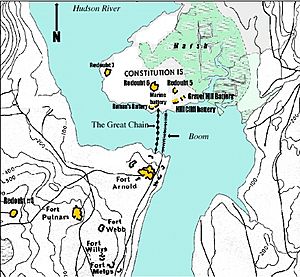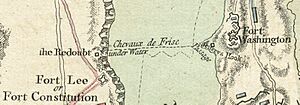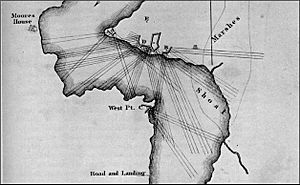Hudson River Chain facts for kids
The Hudson River Chain was a clever defense system built during the American Revolutionary War. From 1776 to 1778, Americans placed huge chains and underwater obstacles across the Hudson River. Their goal was to stop British warships from sailing further up the river. The Continental Army's Highlands Department managed these important projects. The most famous and successful was the Great Chain. It was built near West Point in 1778. This chain stayed in place until 1782, even after the war ended. The giant links for these chains were made at iron factories in Orange County, New York.
Contents
Why the Hudson River Was Important
Both the Americans and the British knew the Hudson River was super important for winning the war. Controlling the river meant controlling travel and supplies. Americans wanted to slow down or block British ships. They planned to attack enemy ships with cannons from forts built along the riverbanks.
In 1776, Henry Wisner and Gilbert Livingston explored the Hudson River. They were part of a secret committee. They suggested putting chains in key spots along the river. This idea led to the building of several river defenses.
Americans built obstacles in a few places. One was near Manhattan, between Fort Washington and Fort Lee in 1776. Another was at Fort Montgomery in 1776–1777. A third was partly built near Pollepel Island. The biggest and most vital project was the Great Chain at West Point. It was put in place every spring until the war ended. The river at West Point was narrow and curvy. This made it hard for ships to navigate. Adding obstacles there made it even tougher for British ships. It also gave American cannons a better chance to hit them.
Underwater Obstacles at Fort Lee and Fort Washington (1776)
To block the river, the Army built chevaux-de-frise. These were like underwater fences made of logs. They were sunk between Fort Washington in Manhattan and Fort Lee in New Jersey. The logs were meant to pierce and sink any British ships that tried to pass over them.
A gap was left for American ships to pass through. But the British found out about this opening from a local person. They managed to sail through the barrier several times. The British captured both forts in November 1776. This made the underwater barrier useless.
The Fort Montgomery Chain (1776–1777)
A chain and a floating barrier called a "boom" were stretched across the river. This was from Fort Montgomery on the west side to Anthony's Nose on the east side. Captain Machin led this construction effort.
In November 1776, a weak link in the chain broke. This happened because of the strong river tides. It showed how hard it was to chain the Hudson River. The chain was fixed and put back in place. But the British captured Fort Montgomery in October 1777. They then took the chain apart and sailed upriver to Kingston.
Governor Clinton, who helped plan the river defenses, was still hopeful. The British never tried to sail their ships through the chain. This made him think that blocking the river was a good idea. After Captain Machin recovered from his battle wounds, he started work on the stronger Great Chain at West Point.
Pollepel Island's Underwater Obstacles (1776–1777)
Another set of chevaux-de-frise was started between Plum Point and Pollepel Island. This was north of West Point. However, these defenses were never fully finished. Their importance faded when the Great Chain was completed at West Point the next year.
The Great Chain at West Point (1778–1782)
The Great Chain was the most important river defense. It was built in the spring of 1778. This very heavy chain was supported by huge logs. It stretched across the Hudson from West Point to Constitution Island.
Building the Great Chain
The chain was made at the Sterling Iron Works in Warwick, Orange County. Some links also came from Long Pond Iron Works in Ringwood, New Jersey. The whole job was done in just six weeks.
The Hudson River at West Point is narrow and has sharp turns. This makes it very hard for large ships to sail through. The Army used this to their advantage. They built the Great Chain to block British ships. The river's "S-Curve" meant big ships had to zig-zag to get through.
American soldiers placed the chain to stop ships. If a ship tried to turn against the strong current and winds, it would hit the chain. This part of the Hudson River has strong tides. This made sailing ships especially difficult. Cannons were placed in forts on both sides of the river. They were ready to destroy any ships that slowed down or stopped at the chain.
Chain Details and Installation
When finished, the chain was about 600 yards long. It had huge iron links, each two feet long. Each link weighed about 114 pounds. The links were taken to New Windsor. There, they were put together. Then, they were floated down the river to West Point on logs in late April.
The entire chain, including swivels and anchors, weighed 65 tons. To keep it floating, 40-foot logs were cut into 16-foot sections. These were waterproofed and joined together into rafts. Short sections of the chain were attached to each raft. Later, in the river, these chain sections were connected. Peter Townsend, who owned Sterling Iron Works, was paid to make the chain.
Captain Thomas Machin, an engineer, installed the chain. He had also put in the chain at Fort Montgomery. On April 30, 1778, he directed the chain's installation across the river. One end was secured to a small cove on the west bank. The other end was anchored to Constitution Island. Both ends were held by log boxes filled with rocks.
A system of pulleys, rollers, and ropes helped adjust the chain's tightness. This helped it handle the river current and changing tides. Every winter until 1783, the chain was removed. It was reinstalled each spring to protect it from ice. A log "boom" was also built about 100 yards downstream from the chain. This boom was like a ladder. It was meant to absorb the impact if a ship tried to break through the barrier.
Effectiveness and Legacy
The British never tried to sail through the Great Chain. Benedict Arnold, who later betrayed the Americans, claimed that a "well-loaded ship could break the chain." But they never tested it. The larger defense system at West Point, including the chain, was designed by the Polish engineer Thaddeus Kościuszko.
After the war, most of the chain was melted down. It was used for other things at the West Point Foundry. A saved part of the chain was first displayed at West Point. It was shown with a captured mortar. Today, it is displayed at Trophy Point. The thirteen links represent the original states. The exhibit is cared for by the West Point Museum. A section of the boom was found in 1855. It is now displayed at Washington's Headquarters State Historic Site.
Two links of the original chain are also at Raynham Hall in Oyster Bay, New York. This was the home of Robert Townsend. He was a spy for George Washington. He was also a cousin of Peter Townsend, who owned the iron works that made the chain.
Over the years, some people have sold fake chain links to collectors. This shows how proud people were of this amazing engineering project.







